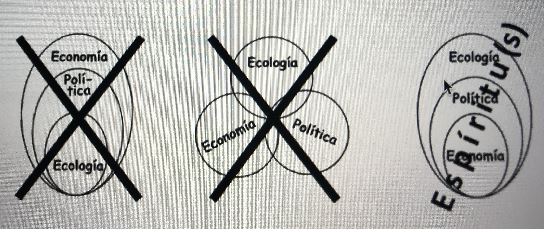EuropeInfos. #180 – March 2015. The monthly Newsletter of the COMECE and the JESC.
In 2013 the European Environment Agency (EEA) announced that Europe had already reduced its greenhouse gas (GHG) emissions by 19% with reference to the 1990 level, but this reduction is largely as a result of the economic crisis.
 In order to tackle climate change there are two possible strategies: mitigation and adaptation. The first strategy consists in reducing the effects of climate change by reducing greenhouse gas emissions; the second track consists in facing up to the impacts and consequences of global warming (drought, flood, shortage of drinkable water…) by adapting our societies to the new environmental conditions. Both strategies are complementary: mitigation attempts to reduce the impacts to which we will, inevitably, have to adapt.
In order to tackle climate change there are two possible strategies: mitigation and adaptation. The first strategy consists in reducing the effects of climate change by reducing greenhouse gas emissions; the second track consists in facing up to the impacts and consequences of global warming (drought, flood, shortage of drinkable water…) by adapting our societies to the new environmental conditions. Both strategies are complementary: mitigation attempts to reduce the impacts to which we will, inevitably, have to adapt.
The strategies attempt to meet the consensus of keeping global warming in 2100 below 2°C as compared with pre-industrial levels. Beyond this level climate change will most probably be dangerous and irreversible. We introduce here some of the most important strategies of mitigation.
Reduction of GHG emission
The Kyoto Protocol is the basis for the policies concerning mitigation. It was signed in 1997 and became effective in 2005. Currently, the Kyoto Protocol is in its second phase (2013-2020). The next UN Conference on Climate Change (COP21) that will take place in Paris in December 2015 is crucial for the renewal of the Kyoto Protocol.
The European Commission proposes, in its last policy framework for climate and energy, a target of reducing emissions by 32% by 2030 relative to emissions in 1990. The main objective is to cut the emissions by 80-95% by 2050 relative to 1990.
Objectives are very different between one State and another. These objectives take account of the history, the specific situation and the economic development of each country. For instance, Sweden has the very ambitious objective of reducing GHG emissions by 17%; while Romania, which is undergoing economic change, is authorized to increase its emissions by 19%.
The EU Emission Trading System (ETS)
The ETS was launched in 2005 by the EU. It is the cornerstone of its strategy to tackle climate change. It consists of trading emission allowances. This scheme sets a ‘cap’: a limit that is established as the total amount of certain greenhouse gases emitted by factories, power plants, and other emitting installations. Companies receive emission allowances that are limited by the cap, and these allowances may then be “traded,” which means sold or bought by one from another as needed.
At the end of each year, the scheme evaluates the volume of emissions effectively produced as compared with the allowances permitted. If emissions are excessive, companies will be fined, but they may keep their spare allowances to cover future needs or they may simply sell them in order to make some profit.
But the Emission Trading System is far from being efficient. With prices currently hovering at 5 euro per tonne, this is below the 20 or 30 euro which price analysts believe is needed to be a real incentive for companies to move to less polluting technologies by allocating or selling the allowances to cover their emissions. Originally the ETS overestimated the allowances allocated to the former Soviet countries, theoretically an industrial power, that in fact collapsed a short time after. Then the economic crisis reduced emissions without a parallel reduction of allowances. The surplus of carbon allowances is estimated to have a value of 3.4 billion euro and the efforts to reduce it have not been successful.
Energy efficiency
A number of measures have been adopted by the EU to improve energy efficiency such as renovation of buildings, energy audits, transparency of products on the market. The EU has already agreed, at an EU summit in October 2014, a new energy efficiency target of 27% or higher by 2030. Every country has a distinctive national energy efficiency target and they are supposed to communicate targets and action plans every two years.
Carbon capture and storage (CCS)
CCS is a technology that traps the CO2 emitted, compresses it and transports it to a suitable storage site. Then it is injected underground. This process avoids releasing CO2 into the atmosphere. The EU adopted a Directive addressing safety of storage sites in 2009. The priority is to protect the health, the environment and suppress potential risks during the process. The cost of this technology is expensive and it forms an important barrier to the implementation of CCS.
We have briefly described the main tools at the disposal of the EU in order to mitigate the effects of climate change. The efforts of the EU to reduce GHG have to be acknowledged and praised, but we also have to point out that the responsibility is greater in those countries that have been polluting for a long time. The EU has to assume its historical responsibility. Then it comes down to a shared responsibility with other big emitters, such as the USA and China. This crisis cannot be resolved only by the efforts of a few, however big they are or they were. This is a global challenge that needs a global response.
Zoé Vanobberghen
JESC




Leave A Comment
You must be logged in to post a comment.